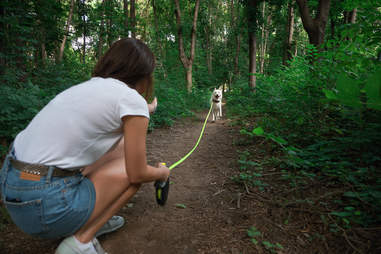10 min read
Sponsored by
Sponsored by

Shutterstock
Soon enough, we’ll be looking to make the most of warm summer days by spending time outdoors — especially with our four-legged companions. Whether that means an off-leash run in the local park, a camping trip in a remote location, or just playing fetch in the backyard, outdoor adventures require a bit more attention when it comes to our pups. To keep your dog happy and protected from things like fleas and ticks, heat, and dehydration, follow these tips when out and soaking up the sunshine.
Watch out for hot surfaces
If pavement or sand is too hot to walk on barefoot, it’s definitely too hot for doggie paws. Plan to walk your pooch in the early morning and evening, when sidewalks are cooler. Keeping them in grassy or dirt areas, rather than on pavement and concrete, during summer afternoons, is key if your pup needs a walk later in the day. If you live in a city and grassy areas are hard to find, dog shoes can help keep paws protected — just be sure to remove them temporarily on longer walks to let his or her paws breathe, as they can contribute to overheating on hot days.
Protect them from fleas and ticks
More time outdoors can also mean an increased risk of fleas and ticks, especially because warmer weather provides the ideal conditions for many of these pests to survive and reproduce. Your best bet is a good defense, like FRONTLINE® Plus for Dogs. It’s easy to apply, and one monthly application will help keep your dog protected from fleas and ticks. When you’re adventuring with your pup outdoors, it’s also important to do a thorough flea and tick check regularly. Taking steps to reduce the risk of fleas and ticks around your home is important too. This can be done by removing the things in the environment that are necessary for flea and tick survival, as well as taking steps to prevent habitats that are frequented by the animals that fleas and ticks feed on. Keep grass cut short and eliminate any brush piles around the yard. Cover crawl spaces and garbage cans to deter wildlife.
Pack first aid supplies
Emergencies can happen at any time. It’s important to be prepared not only when you’re in the comfort of your own home, but also when you’re on a camping trip or hike. Start by ensuring that you have an adequately stocked first aid kit that includes your dog’s medical records, essential contact information and supplies. Include the contact information of your veterinarian, as well as the emergency veterinary hospitals in the area you’ll be visiting, too. As for supplies, you’ll want to pack gauze, bandage material, tweezers, and any other medical supplies that your vet recommends. Of course, carrying a portable dog bowl will ensure your dog has enough to drink on hot days out and about, too. For any emergency situation, you’ll want to get your dog to a veterinarian as quickly as possible. In particular, if your dog is exhibiting signs of heat exhaustion or heat stroke (excessive panting, bright red or dark gums, respiratory distress) rush your pet to the closest veterinarian immediately. And for less serious injuries, you may want to get your pup checked out by your vet once you return as dogs tend to be good at hiding when they are hurt.

Work on recall training
“Recall” is your dog’s ability to come back to you when called — and it’s essential to master before going on wilderness hikes or playing off-leash. Essentially, your dog needs to prioritize this command over their desire to chase after a raccoon or a ball that’s rolled away. The best way to master this is to turn recall training into a game, like hide and seek in the house, or “catch me” while on leash. In both these instances, when your dog successfully returns to you, be sure to shower them with praise and treats. (Pro tip: Don’t immediately put their leash back on once they come, or they’ll associate the command with “playtime’s over!”)
Shelter against the elements
Just like you pack a sweater or light jacket for cool nights out around a campfire, your dog may appreciate some extra warmth, too, especially if you’re camping out in the late spring or beginning of summer. Dog sleeping bags will keep them cozy overnight, while short-haired dogs like French bulldogs or boxers may appreciate a raincoat when the weather turns for the worst. If the temperature at night will fall below 45 degrees, it’s best to look into a sweater or jacket — especially if you have a smaller or senior dog. Warmer than that, though, and they’ll enjoy the summer night air just as much as you will.

Swim with caution
First things first: Not all dogs enjoy swimming — and not all watering holes permit dogs to swim there. That said, if you’ve never taken your pup to a dog-friendly beach or lake before, let them take the lead on dipping their paws in — and never force them into the water if they’re uninterested. Whether your dog enjoys swimming or is just learning, extra caution around water is paramount, and many water-loving dogs benefit from a life jacket. Be sure to get a size that fits your dog properly, and remember that even with a life jacket, your dog still needs to know how to swim and be comfortable around water. Last, consider the temperature before letting your dog jump in — just because it’s warm outside doesn’t mean the water is warm enough for swimming!
FRONTLINE® is a registered trademark of the Boehringer Ingelheim Group. ©2020 Boehringer Ingelheim Animal Health USA Inc., Duluth, GA. All Rights Reserved. US-PET-0252-2020-A
